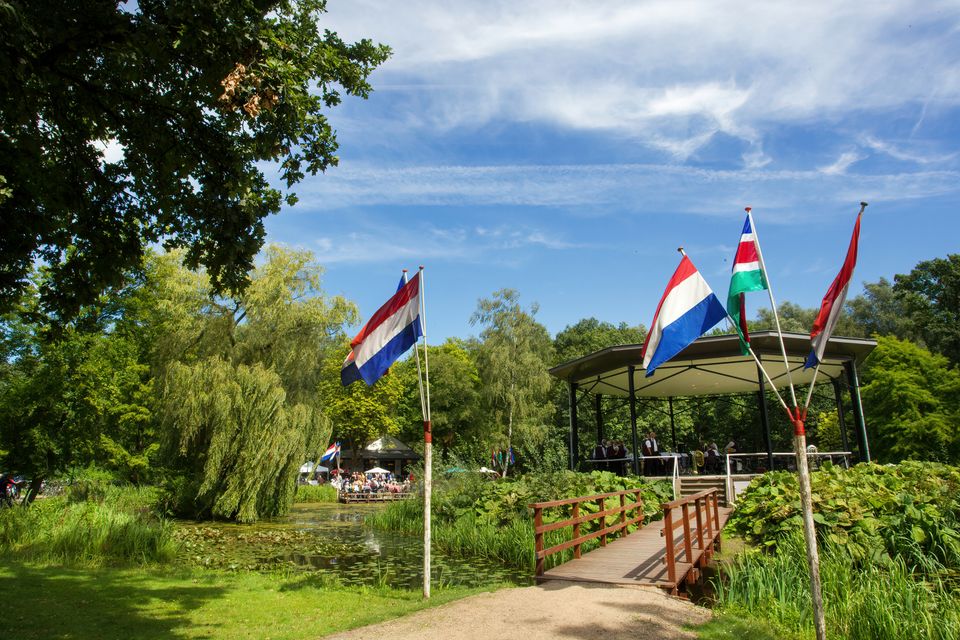Beek en Donk is a twin village (the village of Beek and the village of Donk), former seigniory and former municipality in North Brabant, located in the Peelrand. Beek en Donk has 10,490 inhabitants (1 January 2020, source: CBS). In 1997, the municipality merged with Laarbeek.
Beek en Donk has impressive sights and incredibly beautiful nature that is absolutely worth a visit. Go to all the undiscovered places in the green surroundings.

The Eyckenlust country estate and castle are closely associated with Beek en Donk. Since 1745, it has been owned by the De Jong family of Beek en Donk. The construction of the Zuid-Willemsvaart canal cut through the estate, which before that also extended over land that now lies west of the canal. The castle moat and the gatehouse date from the 18th century. The main building, visible through the gate, was thoroughly rebuilt in the 19th century. Several (monumental) farms belong to the estate and are rented or leased.
Canal Zuid-Willemsvaart is the connection between: Maastricht - Weert - Helmond - 's-Hertogenbosch. King Willem l wanted to connect the industrial area of Liege with the ports of Rotterdam and Amsterdam. Therefore, he ordered the construction of the South Willemsvaart. In 1824, this canal with a length of 122½ km was completed. Beek en Donk owes its development to a large extent to the Zuid-Willemsvaart. The blue unloading crane has been refurbished by the municipality and reinstated on the canal as industrial heritage.
The Blauwe Poort is situated on the north-east side of Beek en Donk. On the west side it borders the Boerdonkse Aa, on the south side the N279, on the east side the Snelle Loop and on the north side the point where the Aa and the Snelle Loop meet. You can take a quiet walk there, enjoy the beautiful view and spot all kinds of water birds!
Two cores in one village
Beek en Donk has two historical centres: Heuvelplein, in the southern part of Beek, and Piet van Thielplein, in the northern part of Donk. In old written sources Aarle and Beek are regularly referred to in one amalgamation: Aarle-Beek. Between Beek and Aarle, since the beginning of the 20th century, is the Wilhelmina canal, which connects here to the Zuid-Willemsvaart that forms the eastern border of the residential area. On the other side of this canal is the hamlet of Bemmer.
Because Beek en Donk consists of two separate centres, a strip of green runs straight through the village, containing the Muziektuin, a music dome from 1927 with a pavilion. Since 2003, the new town hall of the municipality of Laarbeek, which was newly formed in 1997, has been situated in this strip, on the site of the last town hall of Beek en Donk. Just outside the built-up area of Beek en Donk, in the valley of the Aa, lies the country estate with Eikenlust Castle. The park around the estate is accessible but the house is private property.
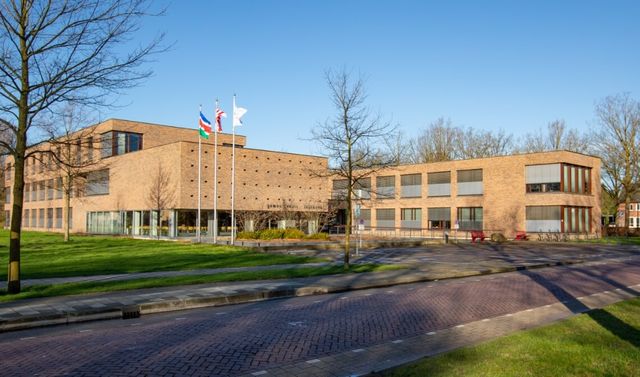
Piet van Thielplein
In 1955, the municipality came up with the name 'Plein 1956', but due to spending restrictions this name could no longer suffice in 1959. Therefore, the municipal council decided on 17 June 1959 to name the square after the founder of the metalworking industry located there: Mr Piet van Thiel. In 1995 Martijn van Hoek established his business 'Eethuis/Cafetaria De Donck' on this square. Interested in the forgotten history, he himself arranged for a Piet van Thiel memorial plaque and the maintenance of the spiked-maker statue, together with the Centrummanagement. He also managed to rename two side streets into the Hendrik and Marinus van Thiel 'aisle'. They were Piet's brothers and stood at the cradle of Helmond factories such as Nedschroef.
Various shops such as Plus van Balkom, the HEMA and the Kruidvat etc. are located on the Piet van Thielplein.
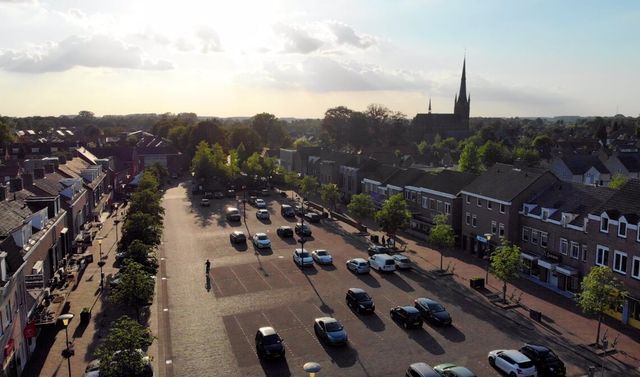
Heuvelplein
The Heuvelplein in Beek is an atmospheric triangular village square with trees, a lime tree and some characteristic old houses. From here, roads led in many directions. It was also the administrative centre of the municipality. The Waterstaatskerk was built in the middle of the square but was demolished in 1936, leaving the square intact. In addition, one can find:
The old town hall; this building at the Heuvelplein was built in 1866 and served until 1971. Since then, exhibitions have been held there. Since 2006, it has also been possible to have marriages celebrated in the old town hall.
Klooster der Zeven Zusters; Formerly the Sint-Josephklooster. This convent was opened in 1895. The architect was Heykant from Erp. The name Zeven Zusters refers to the seven sisters who originally lived here. They belonged to the congregation of the Sisters of Charity of Schijndel. Until 1985, these sisters provided the education. In 2004, the convent was thoroughly renovated and houses were built in it. A large number of houses were also built behind the convent.
There are various shops and businesses on the Heuvelplein, such as Jan Linders, Cafetaria De Smickel, De Snuffelmarkt, Goedemorgen Media and others.
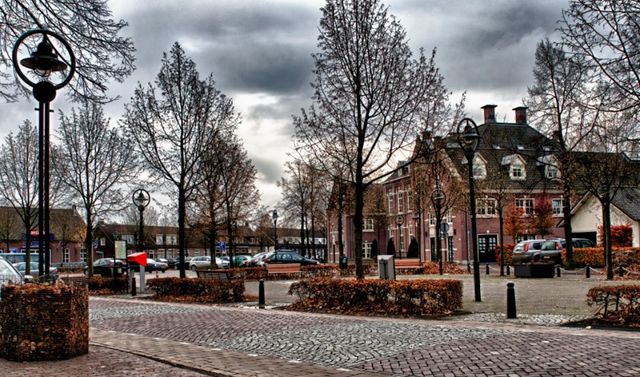
History
Archaeological finds show that the Beek en Donk area has been inhabited by humans since the Mesolithic (Middle Stone Age). The name Donk refers to sandy ridges and the predecessors of today's settlements arose around 650, in Merovingian times, on somewhat higher parts of such ridges. The habitation started in the area of the current Oude Toren at Beek and near the current hamlet Heereind, west of Donk. From 1300 to 1500, the habitation extended to lower parts, such as Broekkant, Donkersvoort, Donk, Bemmer and the Heuvel at Beek. On December 4, 1329, the population was granted municipal rights by Duke John III of Brabant. In 1392, the seigniory of Beek and Donk, together with the seigniory of Stiphout and Aarle, were given on loan to Dirk de Rovere. In 1482, the seigniory came into the possession of Jan Oudart. In 1642, the seigniory of Beek en Donk was reissued and Beek en Donk was separated from Aarle and Rixtel. Around 1400, Beek became an independent parish and the Old Tower dates from this time. In 1422, the St. Leonard's Chapel was founded in Donk, where there was also a nobleman's residence. This was demolished in 1753 and rebuilt in 1979. Industrial activities started after the opening of the Zuid-Willemsvaart in 1825. From 1842 onwards, the Van Thiel company developed in Donk, which manufactured nails (wire nails, wire mesh and later construction steel) and what would later become Nedschroef and Thibodraad. After the Second World War, an industrial estate was established near Beek (Beekerheide east of Oranjestraat).
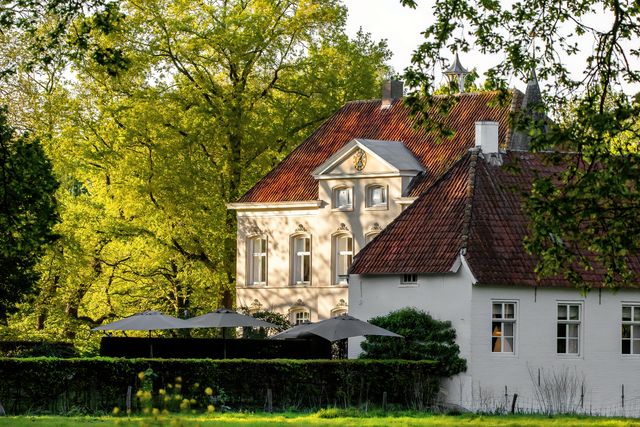
Weapon of Beek and Donk
The coat of arms is derived from two coats of arms of the family of Leefdael/Leefdaal. This family has been in possession of the manor of Beek en Donk from 1643-1745. The first and fourth quarter is derived from the old coat of arms of Rogier van Leefdaal, who was also lord of Hilvarenbeek; his coat of arms is also found in that municipality. This coat of arms is known from a seal of 1306. He himself was not in possession of Beek en Donk.
The second and third quarter are derived from the coat of arms of Philips van Leefdael, who became lord of Beek en Donk in 1643. He had a four-sided coat of arms, identical to the present municipal coat of arms. The coat of arms already appeared on a seal from 1649, so rather soon after Philips acquired the seigniory.
A seal from 1692 shows St. Michael, with the Leefdael coat of arms in front of him, covered by a crown, wound with a string of pearls. The crown was not granted, but was later applied to the new arms of Laarbeek. In that coat of arms for Beek en Donk a mill iron is also included, derived from the coat of arms of the oldest lords of Beek en Donk from the family De Rover.
The coat of arms was initially granted in the national colours. With the second coat of arms the original colours were restored. Initially, the municipality wanted the coat of arms of the De Jong family to be granted. This family, which also supplied the mayor, owned the seigniory at the time. However, a print of the seal with the Van Leefdael coat of arms was sent along. The Adelaide Council took the printout as a starting point and thus granted the Leefdael coat of arms. 
Churches - Monasteries
Until 1894 there was one parish in Beek en Donk, the parish St. Michael. In the year 1894 permission came from the diocese for founding a new parish, which would get the name St. Leonardus parish. The permission to build a new church the Leonardus Church was finally given in 1896. The realisation of the new church is a story of its own. Already in June 1880 there was talk of a second parish in Beek en Donk. The then parish priest of St. Michael's parish was a great opponent of the split. He went to a lot of trouble to prevent it. But in the end, he had to step aside. Piet van Thiel was the great initiator, assisted by Antonius van Empel and Henricus Rooijakkers. The last two were both aldermen in Beek en Donk. In order to obtain permission for the church, financial security had to be provided first. Thanks to the cooperation of many, a solid financial set-up was obtained. After much hesitation, Mr. Fransen was appointed as the architect of the church. He was known as an apprentice of the famous church builder Cuijpers. Mr. Welsing, who only asked for an expense allowance, was not consulted. As a pretext, he was commissioned to design the presbytery. Jacobus Wouters was appointed pastor. The total costs for the construction of the church and parsonage and the demolition of the temporary church amounted to 61,500 Euros. It is worth mentioning that the income of the pastor amounted to Fl. 1215. The contractor was H. Vereijken from Bergeyk. With the sum of Fl. 31,872 for the church he was by far the lowest bidder. During the construction phase, financial problems arose. The church council was forced to hire two lawyers to force the contractor to finish his work.
In 1897, the church was inaugurated. On 25 June 1898, the church was solemnly consecrated by the bishop. During the 1920s, it became apparent that the church was too small for the number of parishioners. It was decided to extend the church with two side aisles. In 1929, under the architecture of Roffelsen from Helmond, the church was extended by contractor van Doren from Veghel for the price of Fl. 34,000. The extension therefore cost more than the new building some thirty years earlier. Data from the diocese concerning the inventory show that the statues in particular were present from the very beginning.
The present Michaelmas Church was solemnly consecrated on 27 May 1935 by Bishop Diepen of Den Bosch. Before the present church was built, the Waterstaat church stood on the Heuvelplein.
This church stood there for 100 years. Before the church was built at the Heuvelplein, the services were held in a barn church. This barn church stood on the Heuvelplein/ Pater Becanusstraat and was used for services for about 150 years. The condition of this primitive barn church was very poor. Although the church, the Old Tower, was returned to the Catholics as early as 1809, the very poor and dangerous condition of the building made it impossible to continue using it. Demolition was the only possibility. Pastor van Abeelen endeavoured to build the church on the Heuvelplein. The total building costs amounted to Fl.18,998.00. During the building of the church, Pastor van Abeelen had a very extensive correspondence with the Diocese. It is remarkable that the church was only consecrated on 5 June 1882 after 46 years! was consecrated. In 1892, Pastor van Roosmalen conceived the plan to beautify the church by modifying the façade. However, he could not get permission from the bishop for this.
In 1919, pastor Thijssen was appointed pastor in Beek. He was the great driving force behind the building of a new church. In a letter dated 12 September 1921, he asked for permission to buy a house and yard located near a piece of land already bought by his predecessors, with the intention of erecting a new church on it in due course. It is not immediately clear what the reason for the new church was. But we do find Father Thijssen's opinion about the water tower church: "The water tower church on the Heuvelplein has always been a clumsy mass, which looks out of place on a Brabanter brink; it is like the devil's laughter in a crowded cathedral. In many conversations that pastor Thijssen had with Herman Thijssens, the pastor made it clear that he would like nothing better than for Beek to have a new beautiful church.
In the meantime it was established that the church was in need of a major overhaul. The roof was leaking and it was very difficult to heat the church in winter. Architect H.W. Valk was hired. He made a design which, after adjustments dictated by the pastor's specific ideas, was finally submitted to the diocese. On 21 February 1933, this plan was approved by Mgr A.F. Diepen. The costs were estimated at Fl.105,751 . Of that amount, the church council was allowed to borrow a maximum of Fl. 50,000. Thanks in part to the sale of the Love house with school, which stood on Heuvelplein and had fetched Fl. 22,000 in 1922, considerable reserves were available. On 20 October 1932, these amounted to Fl. 58,100, a considerable sum for those times. Many of the subcontractors engaged for the construction of the church came from Beek en Donk. Contractor J.M. van Heck en Zonen from Alphen aan de Maas was awarded the job. With Fl. 93,740, he was the lowest bidder.
The many worries of building the new church had become too much for Pastor Thijssen. He died on 5 August 1934. Pastor van Riel succeeded him. The new pastor took up matters vigorously; he did not avoid conflicts. Several lawyers dealt with the conflict between the church council, the pastor and the contractor. All this resulted in a final cost for the new church of Fl.124.260,04. Thanks to the cooperation of the parishioners and also several persons from outside the parish who were willing to lend at a rate of 3.5 %, it was possible to complete the financing. The church was dedicated on 27 May 1935.
In 1980 the parish St. Michael and the parish Leonardus merged into the parish Beek en Donk. From that moment on the parish border was more or less the same as the former municipality of Beek en Donk (with the exception of some outlying areas). The municipality of Beek en Donk merged in 1997 with the municipalities of Aarle-Rixtel and Lieshout to become the municipality of Laarbeek. The Beek St Michael's Church and the Donk St Leonard's Church form the basis for both church communities. The 15th century Old Tower of the former St. Michael's Church, which remained when this place of worship was demolished in the 19th century, overlooks the Laarsche Velden and Beekse Akkers. The church has always stood 'alone on the fields', at a somewhat central point between several hamlets.
Beek en Donk has had three convents in the last century and a half. As early as February 1894, construction began on the new St. Joseph's Monastery under the direction of architect J. Heijkants. To the left was a school with a preschool and four classrooms for the older pupils. To the right of the convent, a wing housed the guest house. The Love House was completed in 1895 and in September of that year seven sisters from Schijndel and their superior moved in. The congregation took over the convent from the church administration in 1922. In 1950, restoration work took place and a side wing with a chapel was built. The convent ceased to exist in December 1996. The nuns then sold the convent to the municipality of Beek en Donk, which wanted to use it as a town hall. From mid-2003 the building was restored to its original state according to the plans of architect Friso Woudstra. However, the municipality of Laarbeek, to which Beek en Donk belonged in 1997, moved its town hall elsewhere. In 2016, the former monastery is now home to an estate agency, among other things.
The Saint Leonardus House in Beek en Donk was founded on 25 June 1913 and was located behind the garden of the vicarage of Pastor Jacques Wouters on the later School Street. It was most likely designed by architect C. Roffelsen, who made the drawings for the chapel in 1912. The sisters had a preschool, a primary school and a sewing school. They also cared for the elderly and ran a boarding house for ladies and gentlemen. The community ceased to exist on 1 September 1960 and in 1967 the house was sold to the Franciscan Sisters of Asten. The building became a day care centre. It was demolished in 1979 for the ORO complex, a residential complex for people with disabilities. This stately brick house had a high roof with two dormers. It had two storeys. Two chimneys and the openwork bell tower determined the silhouette of this house, which was related to the villa architecture of the beginning of the century.
The Saint Joseph Study House in Leefdael House in Beek en Donk was founded in 1937. When their noviciate was established in Nijmegen, the Oblates of Saint Francis were looking for a suitable house for the scholasticate. In 1937, Father Matthias Spiessl bought Leefdael House on the Donk from Willem van Thiel. The house on Pater de Leeuwstraat was built around 1900 for Van Thiel in an eclectic style. The former living room was furnished as a chapel, the room at the back as a refectory. On the second floor, there were chambers. In 1938, Father Bogenberger was put in charge of the scholasticate (=priestly education) or the study house Sint Jozef. Architect Roffelsen from Helmond designed the renovations in 1950. A wing with consulting rooms and other rooms was added on the side. The new chapel, consecrated in 1956, was also designed by Roffelsen. In that year the study hall, the recreation room and the brothers' rooms were also built. The priest training ended in 1965, the house was closed and sold. A department of Padua House was set up there. In the 1990s, the former extensions were demolished and the original Huize Leefdael reappeared. The fathers continued to serve the Leonardus Parish in Beek en Donk until 2000, when they returned the parish to the diocese. From 1980, the building first housed a clinic for people with alcohol and drug problems, and later a restaurant.
